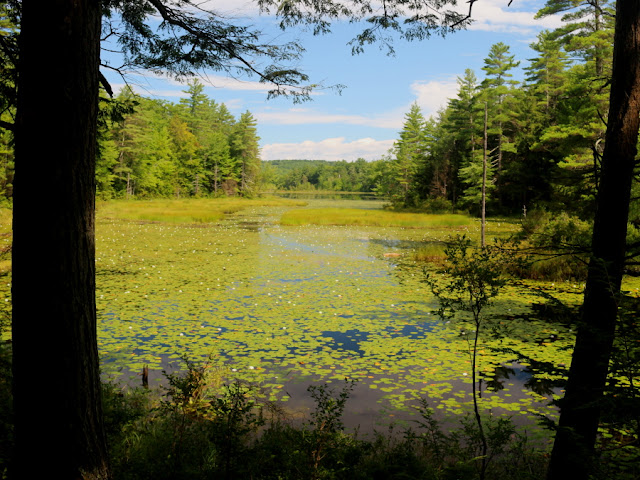 |
| Perhaps a first for Lake Wicwas. |
I've seen amphibious cars launch here before,
 |
| A circa 1965 Amphicar launches into Lake Wicwas. |
but never an amphibious plane.
 |
| Rigging for launch. Photo by Marge Thorpe. |
 |
| The business end of an ultralight. Photo by Marge Thorpe. |
But not phased in the least, the host did her inspection for invasive weeds, crustaceans, (and birds?) and helped the sailor/pilot get on his way.
 | |
|
 |
| Off-duty Lake Host Claranne Bechtler saw him taxing down the lake. (Photo by Claranne Bechtler.) |
If you have ever observed these ultra-lights in flight, you know they aren't quiet, so it was no surprise when Marge heard the vessel return to the lake sometime later. But she was a bit alarmed to hear the sound of a sputtering engine, and then silence. Quickly she and Dave went out to see what transpired, and found the pilot half way down the lake, swimming, pushing his plane back towards the boat ramp. Needless to say, the Thorpes provided a welcome tow back to the ramp.
 |
| You can see the pilot in the water behind his aircraft, using a pusher-stroke. Photo by Claranne Bechtler. |
 |
| Neil Crimins, another Lake Host also saw the action going down on the lake. (Photo by Neil Crimins.) |
 |
| Dave Thorpe provides towing service. Photo by Marge Thorpe. |
The pilot had not allotted quite enough fuel for his entire trip, and had run out of gas on his return flight. He was able to make a dead stick landing onto the lake which was fortunately close enough for him to glide in to. The pilot is from Canterbury and brings his ultra-light around the region exploring different lakes. Keep an eye to the sky and maybe you'll see him flying overhead some time. Just keep an extra fuel tank handy!
There wasn't much nature that could compete with that excitement this week, but I did find evidence of our friendly bears up in the Hamlin conservation area while I was doing some property monitoring.
 |
| A small pile of bear scat, loaded with the fruits of the season. |
And hiking with a couple of good friends over in the Page Pond Town Forest, one of them spotted a handsome wood frog sitting right in the middle of trail.
 |
| A green frog hangs out near the Page Pond mill dam. |
He must have been waiting for a princess to come along.
The new trails on the Barnard Ridge side of the Page Pond are being developed and should be ready by fall. If you travel in that area you will find white blazes going up to mark the new trail. One trail will pass along the far side (west shore) of Page Pond, and will provide some gorgeous views of the pond, a beaver lodge, and several beaver dams.
 |
| Page Pond from the southwest shoreline. |
I'll be sure to let you know when the trails are officially open for use.
There was also a beautiful monarch butterfly chrysalis hanging from a window sill at the Lakes Region Conservation Trusts headquarters building in Center Harbor. (Thank you Phil P. for pointing it out to me!)
 |
| A monarch butterfly chrysalis. |
This is the time to find them - look especially near fields of milkweed and goldenrod which are blooming abundantly now. Milkweed in particular is a special food source for monarchs, as drinking the liquid from the milkweed plant fills their body with toxic cardenolides which makes their bodies poisonous to predators [Ref: University of Minnesota Monarch Lab]. If you have never been to the LRCT headquarters in Center Harbor, you should stop by and check out the gorgeous views and all the maps and other items they have there. They always enjoy having visitors!
Lastly, a status on the loon twins: Harley and Davidson are doing just fine and still spending a lot time with mom and dad.
When they're fishing together and a parent comes up from a dive empty handed the chicks make the strangest little creaking sound, expressing their disappointment, and letting the parent know they are still hungry. But they must be getting enough nourishment as they continue to grow, looking more and more like juvenile loons every day.



No comments:
Post a Comment